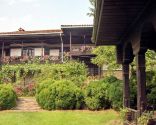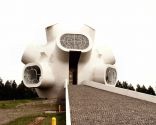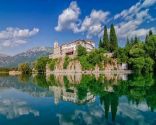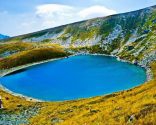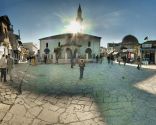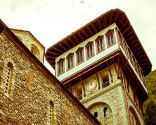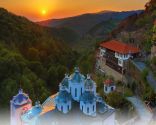Top 10 Macedonia
1. Skopje City Centre
For the last several years the city centre has seen a major transformation and now one can spend an entire day and still not manage to see everything. From the Triumphal Gate (pictured) to the giant statue of Alexander the Great, the numerous museums surrounding the area and the old stone bridge, the cultural offering is simply immense. The area is buzzing with nightlife as well, with many of the city's most attractive bars, coffee shops and restaurants beeing located on the Makedonija street. Shopoholics will have their hands full as well as there are plenty of shops to choose from with two of the biggest shopping malls within a 5 minute walk.
2. Ohrid Old Town & Ohrid Lake
Most of the monuments are located in the old part of the town, near Samouil’s fortress. Located on the highest place in Ohrid, Samouil’s fortress is the most dominating structure even today. Dating from the III century B.C., when Ohrid was a typical antique town with city gates, the fortress got its monumental and urbane framework in the IX-th century, when the city was the stronghold of King Samouil's empire.
Another must visit place in Ohrid is Plaoshnik, which is located right underneath the fortress and will leave you breathless with its astounding history and architecture. Here in 893 A.D. St Clement built the monastery and dedicated it to Saint Panteleimon, the saint who protects people’s health, and shortly after he founded the first European university and in the same place he was buried after his death. In Ottoman time the church was turned into mosque. Today the reconstructed St. Panteleimon church is one of the most visited places in the town.
The Church of St. John at Kaneo, is also on the path through the old town. It is the most iconic landmark in Ohrid, situated on a rock just above the lake. Its beauty and location are synonymous with the town's history together with a fresco of St. Clement and St. Erasmus painted on the walls. It's impossible to choose a postcard of Ohrid without the one with the Church of St. John at Kaneo being one of your favourites.
One of the biggest and most important churches in Ohrid is Saint Sofia church. Built at the beginning of the 11-th century, over the foundation of an early-Christian basilica, it was the cathedral temple of the Ohrid Archbishopric. With preserved fresco- paintings from the 11-th and 14-th centuries, St. Sofia is one of the two churches in Europe with greatest number of frescoes dating from the 11-th century.
3. Old Skopje Bazaar
The old bazaar has been a centre for trade and merchants as early as the 12th century and nowadays it represents an iconic heritage site for the city. It is a vivid representation of the country's past and its inheritance from the Ottoman empire. Still having authentic shops for jewelry and handcrafted products it can be a paradise for collectors of original arts and products . Its coffee and tea shops perfectly fit in the timeless surroundings and offer an original experience for every traveler. Besides the roaming the main street one can visit the numerous sites around the old bazaar such as the covered market bezisten, the old clock tower, cifte hamam and several mosques from ottoman time. The old bazaar is also within a walking distance from the City Centre and Kale Fortress.
4. Monastery of St. Naum - Ohrid
One of the oldest and the richest monasteries in Macedonia is St. Naum’s monastery, and is located 29 km away from Ohrid. Built on an elevated plain on the southern coast of the Ohrid Lake, near the springs of the Drim river, and dedicated to St. Archangel Michail and St. Archangel Gabriel. Its creator St. Naum of Ohrid, contemporary and associate of St. Climent of Ohrid and scholar of Cyril and Methodius brothers, had established this monastery towards the end of his life (900-905). St. Naum was well-known as a healer and miracle-worker, which is witnessed by the motifs in the icons painted in the second zone of his crypt. He died in 910 A.D. and was buried in the monastery. During the Ottoman period the church was demolished. In the XVI and XVII century, the foundation of original structure, was used for the construction of the present church, which was later enlarged several times. As one of the inscription reads, the fresco-painting was completed in 1806, when also the chapel of the tomb of St. Naum was painted. The iconostasis placed in the central part of the church, was performed in 1711 in the technique of shallow wood-carving, and has special artistic value. The throne icons are considered to be among the best achievements of the first half of the 18th century in Macedonia. You’ll enjoy every moment of your visit of St.Noum’s monastery, from arriving here, whatever with a boat through lake Ohrid or by car and passing alongside the biggest springs on the Ohrid coast, to exploring the history and legends connected with this temple. The whole complex is special due to its rare natural beauty, clear waters and the serenity it offers.
5. Monastery of St. Jovan Bigorski - Gostivar
In the western part of Macedonia, above the valley of Radika river, hidden in the beautiful slopes of Mount Bistra and surrounded by an exuberant forest, the monastery St. John the Baptist – Bigorski is ensconced. The monastery affords a magnificent view of the mountain Korab with its two peaks Small and Big Krchin, and of four picturesque villages. The monastery chronicles tell us that it was established in 1021 AD, but the actual buildings that can be seen today originate from the 18th and beginning of the 19th century. The latest construction work was made few year ago after a fire broke out in 2009, which luckily didn’t made any damage to the most valuable object –the monastery church dedicated to St. John – the Forerunner whose construction is very similar to the Holy Mountain monasteries. The iconostasis here is a unique, priceless masterpiece of woodcarving, performed by Miyak craftsmen headed by Petre Filipovski – Garkata. Adjusted to the dimensions of the church, divided in 6 horizontal zones, on a limited space. The masters carved scenes from both the Old and New Testament, presenting more than 500 human images, 200 different animals interwoven in floral ornaments with a realistic presentation of a grape vine, flowers of narcissus, garden roses, oriental fruits and cracked pomegranates, all of them combined in perfect harmony. Another valuable monastery treasure is an icon dating from 1020 with supposedly miraculous healing power.
6. Krushevo
At 1,350m above sea level Krushevo is the highest settlement classified as a city in the Balkans. An integral part of the Baba Mountain this small city that today counts only 9,684 citizens, has a special part in Macedonian culture and history, and at one point in history it was its own Republic.
For the Macedonians, Krushevo is a synonym to the centuries long struggle against Ottoman rule, culminating with the Ilinden Uprising when the freed area was declared a Republic which unfortunately only lasted 10 days, from 2nd of August to the 12th of August, 1903. The rebellion was lead by Macedonian greats Nikola Karev and Pitu Guli. Today the statue Mechkin Kamen stands tall to commemorate the last moments of the uprising when the revolutionaries were killed and Krushevo was burned by an 18,000 strong Ottoman army. Another monument highly identifiable with Krushevo is "Makedonium" which is a massive structure overlooking the city built to commemorate the same uprising.
There are large manifestations on the 2nd of August every year as this day is associated with other milestones in Macedonian history such as the first assembly of the Anti-Fascist Assembly for the People's Liberation of Macedonia (ASNOM), the battle of Ironea in 338 BC and the victory of Phillip II of Macedon against the Peloponnesian city state and the Christian holy day St. Elijah (Sveti Ilinden). Each year there is a traditional Ilinden horseman march from the capital Skopje to Krushevo.
Krushevo is also well known for the astonishing old Macedonian architecture throughout the city and the numerous monasteries and churches surrounding it.
Krushevo must be on your places to visit list when you come to Macedonia.
7. National Parks (Mavrovo/Pelister/Galichica) - Mavrovo/Bitola/Ohrid
Macedonia has three national parks situated on some of the most beautiful mountains in the country.
National Park Mavrovo is located in the westernmost part of the country on the slopes of the highest peak, Mt. Korab. Mavrovo National Park stretches on a surface of more than 72,000ha and has a vertical rise from 600m altitude to more than 2,700 meters. It has a diverse flora and fauna and it is home to the Zare Lazarevski Ski Centre, the Mavrovo Lake and several idyllic villages such as Galichnik and Janche as well as the Monastery of St. Jovan Bigorski that you saw above.
National Park Pelister is located on the slopes of Baba mountain near the second largest city in Macedonia, Bitola. Pelister is well known for its flora and fauna, especially because of the Macedonian pine tree "Molika". Pelister is also a wonderful place for hiking and enjoying the scenery which took nature thousands of years to create. Popular tracks include climbing the "stone rivers" which are crushed rocks on the slopes forming a sight similar to a river flow, hence the name. The glacial lakes are also very popular and are known as "gorski oci" (mountain eyes) and often provide a great destinaton for hikers.
National Park Galichica is unique in the sense that it's located on the same named mountain that overlooks both large natural Macedonian lakes, Ohrid and Prespa. Its amazing views and great picnic spots are a reason enough to visit, but add to the mix the possibilities for adventure sports such as paragliding, mountain biking and hiking you have a destination that puts it on the top 10 Macedonia. Its close proximity to Ohrid and Prespa makes it ideal for dual purpose visiting, you can be enjoying the crisp water of lake Ohrid in one moment and the next biking down the slopes towards Prespa.
8. Berovo
Berovo is surely one of the most beautiful mountainous towns in Macedonia. Small, but charming and historically rich town located in the very eastern part of Macedonia, around 180 km away from the capital Skopje. Lying on both banks of the River Bregalnica with population of 13.941 people, on absolute altitude between 830-900m and favorable climate, Berovo is a town with the highest oxygen concentration at the Balkans. The average annual temperature is 11,1°C, while the temperature in summer is around 19°C.
Berovo has an ample offer of various tourist attractions, with nature being predominant. The Mountains of Maleševo with the pine forests are even compared to the mountainous areas of Switzerland. Through five marked hiking trails (some of them suitable for mountain biking) you can reach several tourist villages, the stunning mountain scenery and Berovsko Lake. If you prefer exploring the Berovo area “on wheels” you have the opportunity to ride part of the “Iron Curtain Trail”, a cycling route that passes through twenty European countries linking memorials, museums, and facilities commemorating Europe’s divided history and united future.
9. Monastery of St. Joakim Osogovski - Kratovo
If you are in north-eastern Macedonia and heading towards the border crossing with Bulgaria, a small detour on an asphalt road will lead you to the monastery founded in 11th – 12th century - Monastery of St. Joakim Osogovski. Hidden in the tranquility, lush forests and greenery of Osogovo Mountains peaks, at the altitude of 825m, Osogovo monastery is considered to be one of the most beautiful monasteries in Macedonia. The complex consists of two churches (one smaller with remnants from the 14th century, and a bigger – cathedral church dating from the 19th century), old restored lodging houses, residential and buildings of more recent dating. The facilities for overnight stay in the monastery were built in the traditional style, used for accommodating visitors, and with the biggest overnight capacity of this kind in the whole country. The large three-nave basilica, built in 1851 by Andrej Damjanov, has 12 domes, which represent the 12 apostles, and open porches on its western and southern sides. The holy relics of Saint Joakim of Osogovo are located to the right of the church entry, underneath the wall with the most impressive wall painting - the portrait of the saint created by Dimitar Andonov Papradishki.The church that wrote in its history surviving an earthquake, demolishing from the Turks, and desolation during the entire 18th century, today is ranked among the most distinguished cathedral churches in Macedonia built during the Revival in the first decades of the 19th century.
10. Gevgelija, the "Macedonian Las Vegas"
Rightfully dubbed the "Macedonian Las Vegas" the Gevgelija region has the highest concentration of five star hotels and casinos built for the sole purpose of thrilling entertainment. This relatively small town is located just 3 km from the border with Greece and is one of the top tourist destinations in the country. The five star resorts offer gambling on a different level and support it with exclusive accommodation, swimming pools, gardens, nightclubs, exclusive restaurants, art galleries, concerts and various philanthropic events. The surroundings are impressive as well with Dojran Lake located just 30 km to the east and Mount Kozhuf with the Ski Centre Kozhuf located 20 km to the west. Your visit here can be as diverse as the exciting games offered on the casino floors.


